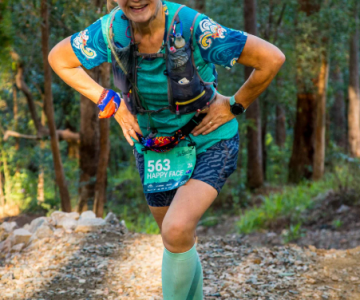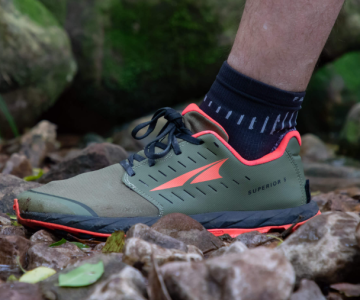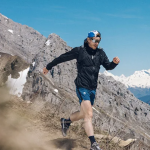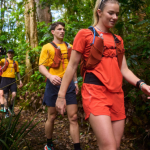When it comes to trail running, your shoes are arguably the most important piece of gear. A well-suited pair will make the tough sections easier, reduce your injury risk, and help you enjoy the miles ahead. But with so many factors to consider—cushioning, fit, traction, and more—how do you choose the right pair? This guide breaks it down to help you find the best trail running shoes for your needs.
Common Trail Running Shoe Misconceptions
Before diving into the details, let’s clear up some common myths that may affect your shoe choice.
Stability Shoes Are a Must
Many runners once believed that “stability” shoes, designed to correct foot motion, were essential for a proper running form. However, this concept is outdated. Your feet naturally have the strength and flexibility to move without excessive support. Instead of relying on overly supportive shoes, look for a cushioned midsole to provide protection while allowing your feet to move naturally.
Zero-Drop Shoes Are Just for Minimalists
Zero-drop shoes, which offer no heel-to-toe drop, aren’t necessarily minimalistic. Some zero-drop models offer substantial cushioning, making them ideal for long-distance runs. If you’re interested in making the switch, a gradual transition can help you adjust to the flatter platform and experience the benefits, like better ground contact and a more natural gait.
Lighter Shoes Make You Faster
A lighter shoe might offer a slight advantage, but the difference in weight is negligible for most runners. A slightly heavier shoe with more cushioning can offer better support, especially on rough terrain. If you’re a beginner, prioritize comfort and support over weight.
What to Look for in Trail Running Shoes
Now that we’ve debunked some myths, let’s focus on the key features that will make or break your trail running experience.
1. Outsole
The outsole’s tread pattern is essential for traction. If you’re running on loose or muddy trails, deeper lugs will provide the grip you need. For harder, dry trails, smaller, tightly spaced lugs are better. For beginners or those unsure of the terrain, a moderate tread with lugs around 3-4mm deep will offer versatility for most conditions.
2. Stack Height
Stack height refers to the cushioning between your foot and the ground. Minimalist shoes have little cushioning and low stack heights, while more cushioned shoes can have stack heights of 30mm or more. If you’re just starting out, go for shoes with at least 25mm of cushioning to protect your joints. More experienced runners may prefer a lower stack height for better trail feel, but beginners and long-distance runners will benefit from more cushioning.
3. Drop
The drop is the difference in height between the heel and toe. Most shoes have a higher heel-to-toe drop, but low-drop shoes (e.g., 4mm or lower) encourage a more natural running form. High drops often lead to a heel strike, which can cause joint strain and inefficiency. A low-drop shoe promotes a midfoot strike, which is better for efficiency and reduces injury risk. However, high-drop shoes may still suit some runners, especially those accustomed to them.
4. Uppers
The upper part of the shoe is critical for breathability and comfort. Shoes with breathable materials keep your feet dry, while waterproof uppers can trap moisture, making your feet a breeding ground for blisters. If you’re running in snow or wet conditions, a waterproof upper may be helpful, but for most trail runs, opt for breathable fabric to allow sweat to escape.
5. Toe Box
A wider toe box allows your toes to spread out naturally, improving your balance and running efficiency. This is especially helpful on long runs when your feet tend to swell. Some runners, especially those with narrow feet, may not prefer the extra space, so it’s important to choose a shoe that fits comfortably around the toes.
Finding the Right Shoe for Your Running Style
Not every runner will benefit from the same type of trail running shoe. Here’s a breakdown of what to look for based on your experience and goals.
New Runners
If you’re new to trail running, choose a shoe that offers a balanced cushioning (at least 25mm) and a drop that feels comfortable. Avoid drastic changes in drop—if you’re used to shoes with a 10mm drop, consider starting with a 6-8mm drop. Ensure there’s enough room for your toes to avoid discomfort during long runs.
Speedsters
For experienced runners looking for speed, a low-profile shoe with a stack height of 20mm or less is ideal. You’ll want to feel connected to the trail, so lighter shoes with less cushioning will help you maintain speed and agility. Make sure the shoe fits snugly, especially around the midfoot, to avoid sliding during quick direction changes.
Long-Distance Runners
If you’re tackling longer distances, go for shoes with more cushioning (25mm or more) and a wider toe box to accommodate foot swelling. Shoes like the Altra Lone Peak, known for their wide toe box, are great for distance runners. Additionally, consider a zero-drop or low-drop shoe for improved running mechanics over long distances.
Getting the Perfect Fit
A good fit is essential for comfort and injury prevention. Here are a few key things to check when trying on trail running shoes:
- Toe Room: Make sure there’s enough space for your toes to move. You should be able to slide two fingers between your heel and the back of the shoe.
- Snug Midfoot and Heel: The shoe should fit snugly around your midfoot and heel to prevent slippage and rubbing. There should be no hotspots or pressure points.
- Comfort Out of the Box: Your shoes should feel comfortable right away. They shouldn’t need a “break-in” period. If they don’t feel right from the start, try another pair.
Conclusion
Choosing the right trail running shoes is a personal decision, but by considering factors like cushioning, drop, toe box width, and fit, you’ll be able to find the pair that best suits your needs. Whether you’re a beginner or a seasoned runner, the right shoes can make your runs more enjoyable and help prevent injuries.





